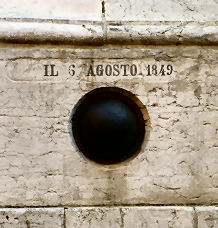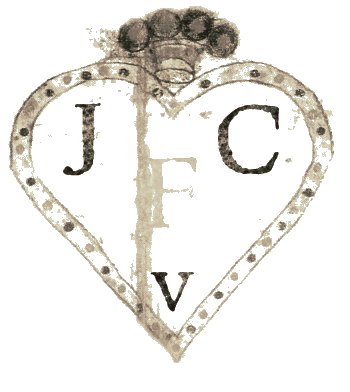|
History Traditionally said to have been one of the churches built, this time in 639, by San Magno (Saint Magnus), to whom Christ the Saviour (Salvatore) had appeared in a dream and sent him a sign - a red cloud this time. The first documented date is 1067. This church is said to have had an iron-grating floor with running water beneath. A rebuilding after the fire of 1106 can be seen on De Barbari's famous map of 1500. It is in the porch of this Romanesque church that Pope Alexander III is said to have taken refuge disguised as a pilgrim and fleeing Emperor Frederic Barberossa. (But another story has him working for six months in the kitchen of the  convent of Santa Maria della
CaritÓ.) In fact he is said to have consecrated this church on 29th August
1177 whilst In Venice to meet Frederick Barbarossa. convent of Santa Maria della
CaritÓ.) In fact he is said to have consecrated this church on 29th August
1177 whilst In Venice to meet Frederick Barbarossa.From 1267 San Salvador housed the relics of the first patron of the city, Theodore, which had previously been in San Marco. The present Renaissance church was begun in 1506 to designs by Giorgio Spavento, with Tullio Lombardo supervising, helped by his father Pietro, following Spavento's death three years after work began. The church was largely completed around 1523, with Jacopo Sansovino responsible for the completion of work from 1530-34 and for the lovely frescoed side entrance onto the Mercerie. The side entrance is said to have been paid for by Girolamo Priuli, along with the Carpaccio painting mentioned below, the cantoria, the organ and the chapel dedicated to Saint Jerome, his name saint, in which he was buried on the 7th of July 1547. The fašade was rebuilt 1649-63 to a design by Giuseppe Sardi with sculptural decoration by Bernardo Falcone. It has an Austrian cannonball somewhat neatly embedded in the bottom left hand corner. The interior The church is monumental with lovely dark grey stone detailing, with the multiple-domed interior harking back to the Byzantine and to San Marco. Despite the darkish stone it's a well-lit church. The interior is designed on mathematical principals, based on the proportion of 2:1 with square bays alternating with half-bays. Relics of Saint Theodore, Venice's original patron saint, are in the chapel to the right of the apse. The walls of the nave is mostly monumental full-height tombs and altars topped by sculpted devotional figures, including an altar of the Scuola dei Luganegheri (Guild of Sausage Makers) with statues by Vittoria of Saint Sebastian (with a metal arrow embedded in the stone) and Saint Roch (with a very discreet sore on his leg) from 1600. They flank an altarpiece by Palma Giovane of Saint Anthony Abbot, John the Baptist and Francis from 1600/3. This is one of a pair of paintings just before the shallow transept - the Titian Annunciation (see below) is opposite. Both transept arms are Cornaro burial spaces. Cardinals Marco, Francesco and Andrea in the left arm, and the tomb of Caterina Cornaro, by Bernardino Contino from c.1580, covers the wall at the end of the right transept. The body of Catarina was brought from its previous resting place in the Cornaro chapel in Santi Apostoli in the late 16th century. Work to repave this transept and embellish the altars flanking Caterina's tomb in the late 1730s included an altarpiece by Giambattista Tiepolo depicting Saints Augustine, John the Evangelist, Louis and a bishop saint, possibly Magno. It was later destroyed in a fire, but is known from two possible sketches. Fontabasso's Saint Leonard altarpiece from the same commission remains in situ opposite where the Tiepolo isn't. Art highlights The great Titian Annunciation of 1563/6 (see below right) sits on an altar by Sansovino, next to his tomb of Doge Francesco Venier. It's one of the few late Titians (he painted it at the age of 90) remaining in Venice in the place for which it was commissioned, by Antonio Cornovi della Vecchia from Bergamo in May 1559. And in case you're wondering why Mary is lifting up her scarf and showing the angel her ear, it's because that was the organ through which the Holy Spirit (specifically The Word) whispered and impregnated her, according to Eastern tradition. The other great Titian is another late one - the damaged but explosive and impressive Transfiguration of 1560 over the high altar, which hides a 14th century silver-gilt reredos revealed only at Christmas, Easter and at the feast of San Salvador on the 6th of August. A pulley lowered the painting on feast days and the canvas suffered from this rough use and had been nastily over-painted to hide damage. Restoration in 1997 revealed the true Titian, conceived as an image to work in its unique situation. A third Titian, a Crucifixion, was commissioned by Flemish merchant Giovanni D'Anna for his family altar right opposite the Cornovi chapel. The D'Anna family suffered financially following Giovanni's death, however, and work on the chapel halted. The Crucifixion is lost, or may indeed never have been painted. The commissioners of these three paintings and Titian himself were all members of the Scuola Grande di San Rocco and there is a possibility that it was a co-ordinated commission. Then there's The Supper at Emmaus (see below) a somewhat stiff piece of work which tradition ascribed to Giovanni Bellini, or a pupil of Bellini called Benedetto Diana (according to Layard) or Carpaccio (according to Crowe and Cavalcaselle) or to Bellini's studio - it depends on which art historian you choose to trust. The church itself used to cover its options by having Bellini and Carpaccio scribbled in biro on masking tape stuck on the plastic sign nearby, with question marks. They then settled on 'Anonymous copy of a Bellini', but restoration in 2011 saw overpainting removed and higher-quality work revealed, with a date of 1513 arrived at and attribution to Carpaccio, painted for Girolamo Priuli, a merchant banker, depicted in black on the right. Many contemporary copies of the composition exist, including two by Catena, but the Bellini original was lost in a fire in the 18th century.
Opening times |
|
|
|
|

Home
Cannaregio ::
Castello :: Dorsoduro ::
Giudecca :: San Marco ::
San Polo :: Santa Croce
:: The Islands :: Demolished